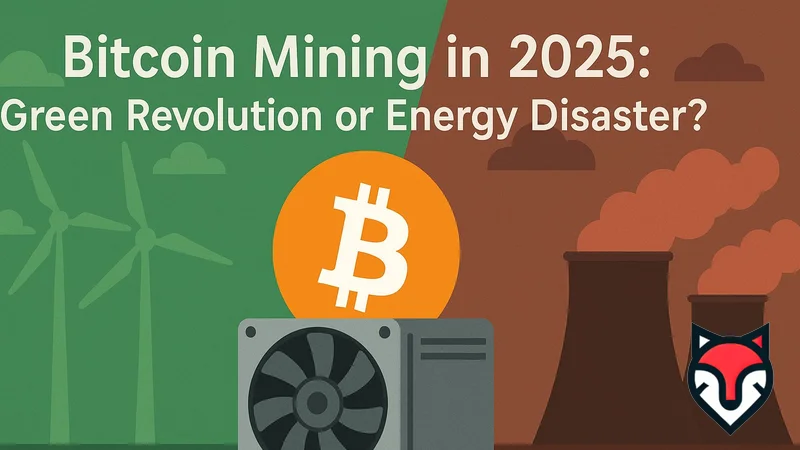Suggested
News
Last updated: Thursday, April 10, 2025

Bitcoin Mining in 2025: Green Revolution or Energy Disaster?
It’s April 9, 2025, and Bitcoin mining stands at a pivotal crossroads. Once vilified as an energy-guzzling behemoth, it’s now flirting with a greener image—powered by renewables, slashing emissions, and even stabilizing grids. Picture a mining rig in Texas humming on solar power or a Vietnamese farmer using hydropower to secure the blockchain. Yet, the specter of its past looms large: coal-fired plants, skyrocketing carbon footprints, and a reputation as an environmental villain. Is Bitcoin mining sparking a green revolution, or is it still an energy disaster waiting to unravel? Let’s dive into the data, trends, and real-world impacts to find out.
The Energy Appetite of Bitcoin Mining
Bitcoin mining isn’t your average tech operation—it’s a power-hungry beast. Miners race to solve cryptographic puzzles, validating transactions and earning rewards, all while burning through electricity like a small nation. By 2025, estimates peg Bitcoin’s annual energy use at over 150 terawatt-hours (TWh)—enough to rival countries like Argentina or Sweden. Back in 2021, critics pointed to its reliance on fossil fuels, with coal and gas dominating the mix. Fast forward to today, and the narrative’s shifting. Renewable energy sources—solar, wind, hydro—are creeping into the equation, driven by cost savings and regulatory pressure. But is it enough to flip the script?
The numbers tell a tale of two worlds. In 2023, studies claimed over 50% of Bitcoin mining tapped renewables, a leap from the coal-heavy days of China’s dominance. After Beijing’s 2021 crypto crackdown, miners fled to places like the U.S. and Canada, chasing cheap, green power. Yet, fossil fuels still cling to a chunk of the pie—natural gas in Texas, coal in Kazakhstan. For every kilowatt-hour mined, emissions vary wildly based on the source. Hydropower? Near-zero carbon. Coal? A climate nightmare. Bitcoin mining’s fate hinges on this energy mix.
A Green Revolution in the Making?
Could Bitcoin mining be a hero in disguise? Advocates say yes, and they’ve got a compelling case. Miners are uniquely flexible—they can set up shop anywhere with power and an internet connection. This mobility lets them tap stranded energy, like excess solar in California or wind in remote Siberia, that might otherwise go to waste. In 2025, companies like Riot Platforms are pairing mining rigs with renewable projects, boosting profitability for green energy developers. A solar farm in Nevada, once struggling to sell surplus power, now fuels a Bitcoin operation, cutting curtailment and emissions.
Then there’s methane mitigation. Oil fields often flare excess gas—a potent greenhouse contributor. Enter Bitcoin miners with portable rigs, converting that waste into electricity. In places like North Dakota, this slashes emissions by up to 63% compared to flaring, while padding miners’ wallets. Peer-reviewed papers from 2024 even argue Bitcoin could accelerate the renewable transition, incentivizing new wind and solar capacity. By 2030, some predict 70% of mining could run on clean energy, a green revolution fueled by profit, not altruism.

The Energy Disaster Counterpoint
Hold the applause—critics aren’t buying the green hype. Bitcoin’s energy use is still colossal, and renewables don’t erase that fact. In 2025, a single Bitcoin transaction guzzles around 1,200 kilowatt-hours—enough to power a U.S. home for 40 days. Compare that to a Visa swipe, which sips just 0.0001 kWh. Even if half the network runs on hydro, the other half often leans on dirtier sources. Take Texas: miners flocked there for cheap power, but when heatwaves hit, they’ve strained grids already reliant on gas, jacking up bills for locals by billions.
The carbon footprint’s no picnic either. Estimates from 2023 pegged Bitcoin’s annual emissions at 85 million metric tons of CO2—akin to 18 million cars. In 2025, that’s likely climbed with rising hashrates. Revived fossil plants, like New York’s Greenidge, churn out power solely for mining, spewing emissions in serene locales. And don’t forget e-waste: mining rigs burn out fast, piling up discarded hardware equal to a small country’s tech trash. For every green stride, detractors see an energy disaster lurking.
Who’s Steering the Ship?
The players shaping Bitcoin mining’s future are a mixed bag. Innovators like Daniel Batten push the green narrative, highlighting off-grid mining’s renewable edge—28% of the global hashrate by 2024. Firms like Marathon Digital aim for 70% carbon neutrality, banking on hydro and wind. Meanwhile, regulators are circling. New York’s 2022 fossil fuel mining ban sent shockwaves, while Texas offers tax breaks to lure miners, hoping to curb methane. Globally, the EU’s eyeing stricter emissions rules, nudging miners toward cleaner tech.
Miners themselves are pragmatic. Profit drives them—cheap power, green or not, wins. In Vietnam, a startup pairs hydro with mining, dodging grid fees. In Iceland, geothermal keeps rigs humming sustainably. But in coal-rich regions like Inner Mongolia, old habits die hard. The clash between profit and planet defines this saga, with pioneers and policymakers wrestling for control.
Bitcoin Mining in Daily Life
Bitcoin mining isn’t just a tech debate—it’s hitting the ground. In rural Canada, a farmer powers his rig with a small wind turbine, selling excess BTC for profit. In El Salvador, a volcanic geothermal plant mines state-backed Bitcoin, blending crypto with national grids. Even urbanites feel it—rising utility costs in mining hubs like Plattsburgh, New York, trace back to crypto’s appetite. From stabilizing renewable projects to spiking your electric bill, Bitcoin’s reach is personal, tangible, and growing.
Take a Hanoi coder: he mines BTC on solar panels, offsetting costs in a shaky economy. Or a Texas oil worker, where rigs turn flared gas into cash. These snapshots show Bitcoin mining weaving into everyday systems—sometimes green, sometimes greedy. It’s not abstract; it’s power lines, wallets, and waste.
The Road Ahead: 2025 and Beyond
What’s next for Bitcoin mining? The green revolution could gain steam. By year-end, expect more solar-powered rigs in sunny climes like Australia, or hydro setups in Scandinavia. Analysts forecast DeFi and mining merging closer, with tokenized carbon credits—like KlimaDAO’s—offsetting emissions. If miners hit 70% renewables by 2030, Bitcoin might shed its dirty label. Tech tweaks, like AI optimizing energy use, could trim waste further. Some even whisper of space-based solar powering blockchain—a wild, distant dream.
But the disaster risk looms. Without global coordination, fossil fuels could cling to mining’s core. Grids might buckle under unchecked growth, especially in developing nations. Rising difficulty post-halving (next in 2028) will demand ever-more power, testing efficiency gains. Check CoinDesk or cryptostats.xyz—the data’s live, and the stakes are high.
Why It Matters to You
Bitcoin mining in 2025 isn’t a niche topic—it’s your energy bill, your climate, your crypto wallet. It’s a tug-of-war between innovation and excess, with real-world wins and losses. Searching ‘Bitcoin mining green revolution’ or ‘crypto energy disaster’? You’re here at the pulse. This isn’t just about miners or tech geeks—it’s about power shifting, literally and figuratively. So, is Bitcoin mining saving the planet or draining it dry? The answer’s unfolding now—what’s your take?
Suggested Articles
For You
Related Articles
- Hybrid Consensus in 2025: Can PoW and PoS Together Revolutionize Blockchain?
- The Rise of DAOs in 2025: Revolutionizing How We Build and Run Organizations
- What Bitcoin’s Blockchain Can Teach Big Tech About Trust in 2025
- The Psychology of Bitcoin in 2025: Fear, Greed, and FOMO Dissected
- How Bitcoin’s Next Upgrade Could Change Everything in 2025
- Is MetaMask Wallet Worth the Hype for DeFi Fans in 2025?












